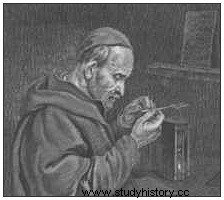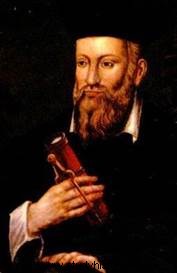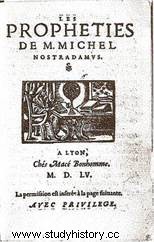 Doctor during the great waves of plague epidemics that affected Languedoc, then ordinary doctor to the king to Charles IX, Michel de NostreDame , says Nostradamus , acquired his reputation thanks to his prophecies published in the form of quatrains grouped together by the hundreds, called Centuries and published in Lyon in 1555. They earned him the immediate favors of the Court and Catherine de Medici the order to establish the horoscope of his three sons. His gifts would have been confirmed at the death of Henri II, whose circumstances he would have predicted. Humanist of the Renaissance, open to the ideas of the Reformation, he knew how to take an interest in medicine and pharmacy while succeeding in fighting the worst evil of his time:the plague.
Doctor during the great waves of plague epidemics that affected Languedoc, then ordinary doctor to the king to Charles IX, Michel de NostreDame , says Nostradamus , acquired his reputation thanks to his prophecies published in the form of quatrains grouped together by the hundreds, called Centuries and published in Lyon in 1555. They earned him the immediate favors of the Court and Catherine de Medici the order to establish the horoscope of his three sons. His gifts would have been confirmed at the death of Henri II, whose circumstances he would have predicted. Humanist of the Renaissance, open to the ideas of the Reformation, he knew how to take an interest in medicine and pharmacy while succeeding in fighting the worst evil of his time:the plague.
Michel Nostradamus, doctor...
Michel de Nostredame was born in mid-December 1503 in Saint Rémy de Provence. He comes from a family of Jews expelled from the kingdom by Philippe Le Bel at the beginning of the 16th century who were then welcomed by Pope Clement V around Avignon, in quarries, closed streets. The only constraint:they had to wear a yellow cap when they went out.
 Pursuing brilliant studies where he wrote Latin and Greek fluently, he was enrolled at the University of Montpellier and received a "bachelor of medicine" in 1525. Being Jewish, he converted to Catholicism to enter the university and chooses for baptismal name Nostradamus which is transformed into Michel de NostreDame. In his house in Salon, the same one he occupied until his death, at the foot of the Château de l'Empéri, above his desk, hangs a manuscript yellowed by time, dated October 1529 "me, Michel de Nostredame, from the house of Provence, from the city of Saint Rémy, from the diocese of Avignon, came to study at the University of Montpellier, whose present and future statutes, rights and privileges I swear to observe. I have paid the registration fees and I have chosen Antoine Romier as my tutor”.
Pursuing brilliant studies where he wrote Latin and Greek fluently, he was enrolled at the University of Montpellier and received a "bachelor of medicine" in 1525. Being Jewish, he converted to Catholicism to enter the university and chooses for baptismal name Nostradamus which is transformed into Michel de NostreDame. In his house in Salon, the same one he occupied until his death, at the foot of the Château de l'Empéri, above his desk, hangs a manuscript yellowed by time, dated October 1529 "me, Michel de Nostredame, from the house of Provence, from the city of Saint Rémy, from the diocese of Avignon, came to study at the University of Montpellier, whose present and future statutes, rights and privileges I swear to observe. I have paid the registration fees and I have chosen Antoine Romier as my tutor”.
At that time, the plague raged throughout the south of France. He travels all the roads of Provence and the South West to fight this disease, having learned the basics of pharmacy and after one of his ancestors passed on his knowledge of botany, the virtues of plants and preparations.
In his "treatise des Fardements et Jams", he begins by giving a very detailed description of this bubonic or pulmonary disease. To fight this scourge, he makes a mixture of eggs and plants. He invented an aromatic vinegar with antiseptic qualities and developed a "sovereign powder" against contagion. Advising simple rules of hygiene and advocating the principle of "prevention rather than cure", he then suggested cleaning the houses with vinegar, spreading plant essences, leaving a lighted torch in the rooms and above all covering the nose and mouth.
A few years later, the plague struck again in the towns of Salon and Aix. And here he is again on the roads…until Lyon. He prepares an “excellent powder which drives away pestilential odors”. Its recipe is composed of cypress sawdust, Florence iris, cloves, musk, ambergris, aloe and incarnadine roses. It is all the rage during this period of contagious disease when more than one throws themselves out of the window, where more than one perishes before this scourge.
...pharmacist and master jam maker
 His dedication during the plague made him famous. Gradually, the ladies call on him:he elaborates the "ointment of a sovereign odor", "oil to embellish the face", "ointments to make the hair appear like a net of gold » ….in short, recipes that bring in money and success.
His dedication during the plague made him famous. Gradually, the ladies call on him:he elaborates the "ointment of a sovereign odor", "oil to embellish the face", "ointments to make the hair appear like a net of gold » ….in short, recipes that bring in money and success.
At Christmas 1547, in his town, he married Anne Ponsard…who bore him 7 or 8 children. Then until 1549, he went into exile in Italy to deepen his knowledge of vegetable alchemy. In Milan, he discovered an apothecary specializing in this field, who introduced him to healing jams. Back in Salon, Michel de NostreDame experimented with these medicated jams and in 1552, he published the results of his research under the title "traité des Fardements et Confitures".
In his jams, he adds spices, invents processes to enhance and flavor wine, prepares vinegars and herb mustards, which he sells. Then noting that the ladies have a new desire:to become blonde, he enriches himself with his potion which allows "to have under 3 or 4 days, blond and red hair like ducat gold". He goes further, he thinks of men who want to please the youth and of women worried about their partner's virility. He creates a remedy "repopulation oil" famous even in Italy.
The prophecies of Nostradamus
Having attracted the jealousy of his colleagues by the success of his cures, Nostradamus retired to Salon. Between 1555 and 1558, he published his famous prophecies in two volumes of centuries which enjoyed immense success. Using a "convoluted" language, these quatrains grouped by the hundreds are supposed to describe events to occur between 1550 and the end of the world, scheduled for 3797 AD. Many people will try to interpret these prophecies and establish a link with events that have already taken place.
The fame of Nostradamus is such that Catherine de Medici calls him to court to become the ordinary doctor of Charles IX. The queen mother takes the opportunity to ask him to establish the horoscope of her three sons. The gifts of Michel de NostreDame would have been confirmed during the accidental death of Henri II, the circumstances of which he would have predicted. A quatrain, published in 1568, would have predicted his death on July 2, 1566. His remains were buried in the Church of Saint-Laurent in Salon-de-Provence.
To go further
- The prophecies of Nostradamus. Archipoche, 2013.
- Treaty of Nostradamus jams. Imago, 2015.
- Catherine, Nostradamus and the Black Triangle – Claude Mossé. Alpheus, 2010.
